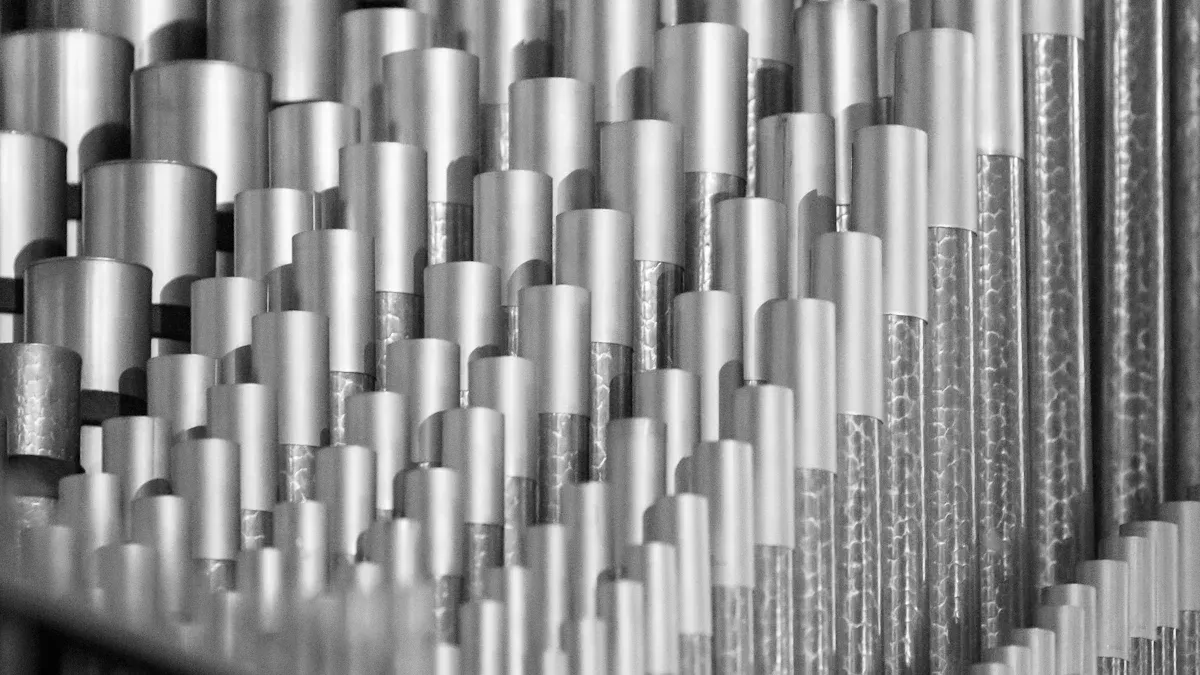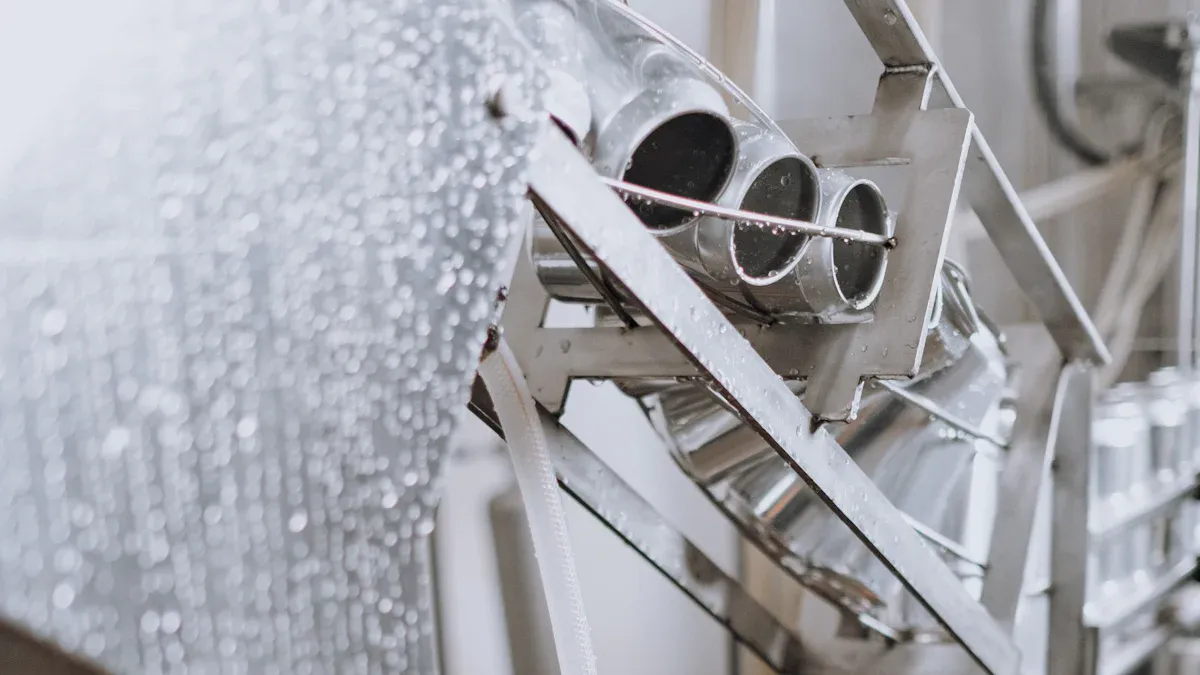How Aluminum Extrusion and Die Casting Processes Work

Aluminium extruded and die-casted methods are essential techniques for shaping aluminum. Extrusion involves pushing aluminum through a mold to create long, uniform shapes, while die casting utilizes molds to produce intricate designs. These processes are vital for various industries, including automotive, aerospace, and electronics. For instance:
The global aluminium die-casted market may reach $144.74 billion by 2030.
Over 70% of all aluminium produced is still in use due to its recyclability.
Aluminium extruded components can make vehicles lighter by up to 40%, which helps save fuel and reduce pollution.
These techniques contribute to modern manufacturing's sustainability and innovation. Products made from aluminium extruded and die-casted methods are highly valuable.
Aluminum Extrusion Process
How Aluminum Extrusion Works
Aluminum extrusion shapes aluminum by pushing it through a die. First, billet preheating heats aluminum billets to 700-930°F (370-500°C). This makes the aluminum soft and easy to shape. The heated billet is placed in the extrusion press. A hydraulic ram then pushes it with 1,000 to 15,000 tons of pressure. The aluminum comes out of the die in the desired shape. Afterward, the shaped aluminum is cooled and prepared for use.
This process creates precise and uniform shapes. It is useful in industries like construction and automotive. These industries need materials that are strong and lightweight.
Role of the Die in Aluminum Extrusion
The die is important for shaping aluminum during extrusion. It decides the product's size and surface quality. Engineers design and test dies to improve results and reduce problems.
The die keeps shapes accurate under high pressure.
It helps create detailed designs with smooth surfaces.
Good die design reduces waste and increases efficiency.
By improving die designs, manufacturers make reliable products. This makes aluminum extrusion useful for many purposes.
Benefits of Aluminum Extrusion
Aluminum extrusion has many benefits for different industries. Its resistance to rust lowers maintenance costs. Standard profiles make manufacturing faster and easier. Pre-made designs also help create better products.
Here’s how industries use aluminum extrusion:
Application Sector | Key Benefits |
|---|---|
Construction | Strong, rust-resistant, and looks good |
Electric Vehicles (EVs) | Lightweight parts improve battery life and performance |
Aerospace and Defense | Handles both hard and soft aluminum well |
Recycled Aluminum | |
Marine | Flexible designs for various engineering needs |
Automotive | Lightweight parts save fuel |
Aluminum extrusion supports eco-friendly and innovative manufacturing. It creates strong, light, and precise parts, making it essential for many industries.
Die Casting Process

How the Die Casting Process Works
Die casting uses melted metal to make parts in molds. First, engineers design the mold using special computer software. The mold is usually made of steel or aluminum. Next, the metal is melted until it becomes liquid. Machines push the liquid metal into the mold with high pressure. After the metal cools, the mold opens, and the solid part comes out.
Special tools like CFD and FEA help improve this process. CFD makes sure the metal flows smoothly, avoiding trapped air. FEA helps the metal cool evenly, making the part stronger.
Description | |
|---|---|
1. Mold Design | Engineers create a mold using computer software. |
2. Metal Preparation | Aluminum or zinc is melted for use. |
3. Injection Process | Liquid metal is pushed into the mold. |
4. Casting Process | The mold opens, and the cooled part is removed. |
5. Finishing Process | The part is treated to improve strength and look. |
Precision and Complexity in Die Casting
Die casting makes detailed parts with great accuracy. Machines push metal into molds at very high pressure, between 10-175 MPa. This fills the mold completely, creating exact shapes. Sensors check important things like temperature and pressure. These checks ensure the parts are always high quality.
This process can make designs that other methods cannot. Vacuum die casting removes trapped air, making parts stronger. Low-pressure die casting fills molds smoothly, reducing mistakes. These methods create lightweight, strong parts with smooth surfaces.
Advantages of Die Casting
Die casting has many benefits for making aluminum parts. It creates detailed shapes that are both strong and light. This is useful for industries like cars and airplanes. The process is fast and saves money by making many parts quickly.
Advantage | Description |
|---|---|
Complex Geometries | Makes detailed and unique shapes. |
High Strength-to-Weight Ratio | Creates parts that are strong but not heavy. |
Cost-Effectiveness | Saves money by producing parts quickly. |
Excellent Thermal Conductivity | Helps parts handle heat well. |
Design Flexibility | Works for many different industries. |
Die casting is very important for modern manufacturing. It makes strong, detailed, and useful parts. Together with aluminum extrusion, it helps create better products for many industries.
Applications of Aluminum Extruded and Die-Casted Products
Uses of Extruded Aluminum in Industries
Extruded aluminum is important for industries needing strong, light materials. It is used in construction for curtain walls and thermal doors. Its rust resistance makes it great for outdoor use.
In electronics, extruded aluminum helps cool devices like heat sinks. These parts remove heat, keeping electronics working longer. In transportation, it reduces vehicle weight, saving fuel and cutting pollution.
Here are some examples of extruded aluminum in action:
Case Study | Description |
|---|---|
The Tall Skyscraper | The Burj Khalifa uses aluminum frames for strength and energy savings. |
The Modern Greenhouse | The Eden Project uses aluminum to create open spaces for plants. |
The Huge Airport | Beijing Daxing Airport uses aluminum to support its large terminal and improve flow. |
Applications of Die-Cast Aluminum Components
Die casting makes detailed, strong aluminum parts for many industries. In cars, it’s used for engine parts, gearboxes, and light frames. Electronics use it for casings, control panels, and lights.
Die-cast aluminum is also used in aerospace, shipping, and appliances. It creates complex shapes with great accuracy. For example, vacuum die casting makes parts stronger for tough environments.
Industry/Application | Type of Aluminum Product |
|---|---|
Automotive | |
Electronics | Die-cast aluminum parts |
Communication devices | Die-cast aluminum parts |
Aerospace | Die-cast aluminum parts |
LED lighting | Die-cast aluminum parts |
Comparing Applications of Both Processes
Extrusion and die casting are both useful but for different jobs. Extrusion is best for light, custom designs like doors and radiators. It’s cheaper for small batches and resists rust well.
Die casting is better for making detailed, strong parts in large numbers. It’s great for industries like cars and airplanes. While extrusion offers flexibility, die casting provides strength and precision.
Tip: Use extrusion for light, custom parts and die casting for strong, detailed ones.
Key Differences Between Aluminum Extrusion and Die Casting
Process and Methodology
Aluminum extrusion and die casting shape aluminum in different ways. In extrusion, heated aluminum is pushed through a die to form long shapes. This method is great for making lightweight and rust-proof materials. Die casting, however, injects melted aluminum into a mold using high pressure. This creates detailed and complex parts with high accuracy.
Extrusion works best for making rods, tubes, and frames. Die casting is better for creating intricate items like engine parts and electronic covers. Both methods have unique advantages for specific uses.
Cost and Efficiency
The cost of each method depends on how many parts you need. Die casting is cheaper for making large amounts of parts. The more parts you make, the lower the cost per piece. But the molds for die casting are expensive, so it’s not ideal for small projects.
Extrusion is a better choice for smaller production needs. It doesn’t require costly molds and still makes high-quality parts. This makes it a good option for custom designs or limited production runs.
Die casting: Best for making many parts.
Extrusion: Cheaper for smaller batches.
Product Characteristics and Suitability
The products made by these methods have different features. Extruded aluminum is light, resists rust, and is easy to shape. It’s used for things like building materials, car frames, and heat sinks.
Die-cast aluminum is stronger and lasts longer. It can create detailed shapes and is perfect for parts needing strength and precision. For example, it’s often used in car engines and airplane equipment.
Tip: Use extrusion for light, flexible designs and die casting for strong, detailed parts.
Aluminum extrusion and die casting are key ways to shape materials. Extrusion makes light, rust-proof items, while die casting creates strong, detailed parts. Both methods are used for different needs, like buildings or vehicle parts.
Note: Learning about these methods helps pick the best one for your work.
Look into these processes to see how they improve projects. Whether you need light designs or strong parts, aluminum offers smart solutions for many uses.
FAQ
What is the main difference between aluminum extrusion and die casting?
Extrusion pushes hot aluminum through a die to make long shapes. Die casting pours melted aluminum into molds to create detailed parts. Extrusion is great for light designs, while die casting makes strong, complex items.
Can aluminum extrusion and die casting use recycled aluminum?
Yes, both methods can use recycled aluminum. This helps reduce waste and supports the environment. Recycled aluminum stays strong and high-quality, making it a smart, eco-friendly choice.
Which industries benefit most from aluminum extrusion?
Construction, automotive, and electronics industries benefit the most. Extruded aluminum is light, rust-proof, and flexible. It’s used for building frames, car parts, and cooling devices in electronics.
Why is die casting preferred for high-volume production?
Die casting is faster and cheaper for making many parts. It creates accurate, detailed items with little waste. This method is perfect for industries like cars and airplanes that need strong, precise parts.
How do you choose between extrusion and die casting?
Pick extrusion for light, simple items like frames or tubes. Choose die casting for strong, detailed parts like engine pieces. Think about cost, volume, and product needs before deciding.
Tip: Talk to a manufacturing expert to pick the right method for your project.
See Also
Exploring Anodizing Applications in Die Casting Products
Comprehensive Guide for CAD Design in Die Casting
Understanding Functional Testing in CNC and Die Casting
Exploring Advantages of CAE Analysis for Die Casting
Finding Optimal Closing Force for Your Die Casting Product
About Hunan Puka
Established in 2016 and based in Hunan, China, with a liaison point in Berlin, we are a Tier 2 supplier for the automobile industry. We specialize in the production of customized aluminum die-casting parts designed for machines with a closing force ranging from 280 to 1250 tons, with subsequent manufacturing process CNC machining and surface treatment. Our commitment to quality is reflected in our accredited quality management system, certified by ISO9001:2015 and IATF16949:2016 standards.


